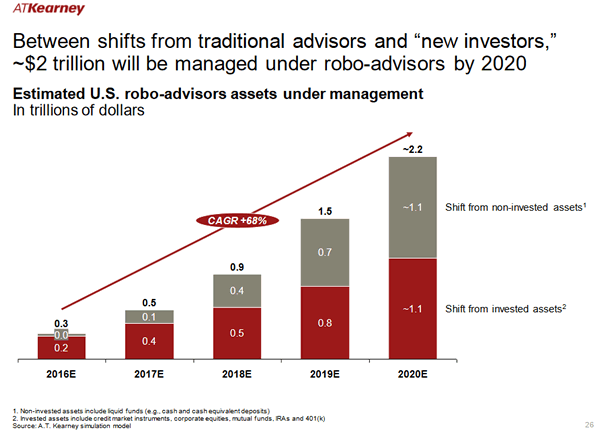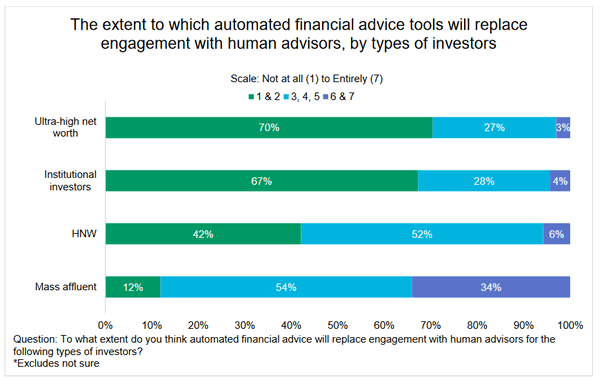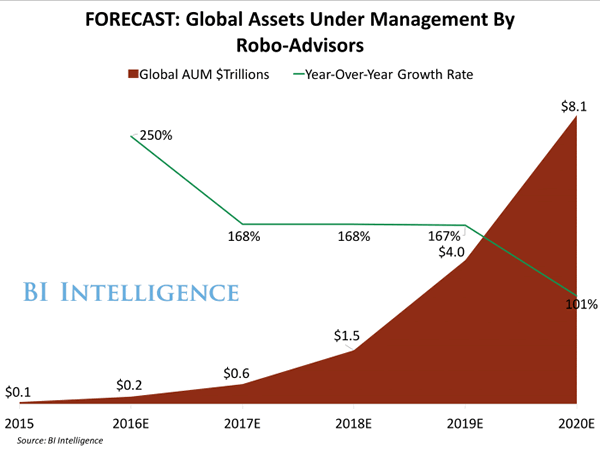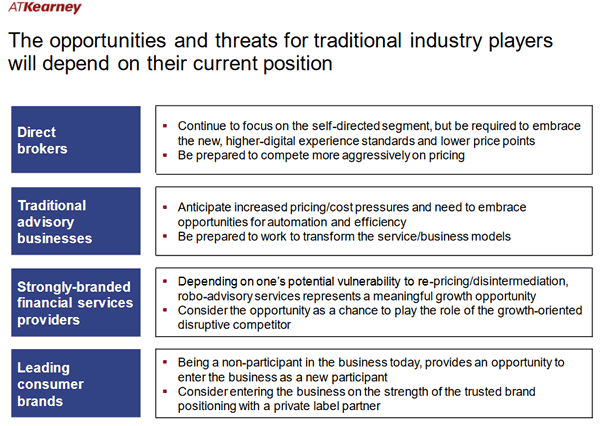Managing and, preferably, optimizing your full financial portfolio, an investment portfolio, a pension plan and so on is traditionally a human task.
It is done by various possible people such as investment managers, wealth managers, financial advisers and even accountants. Since just a few years a range of new fintechs hit the market with so-called robo-advisers or automated financial advice tools. They have been popping up (and keep popping up) in no time and some already even dissapeared.

Robo-advisers: an active but also much debated market
Automated financial advice and optimization is a hot and diverse market with the launch of several platforms, digital and/or mobile in the digital transformation of financial services.
It’s also a market in full flux with a hybrid robo-human approach seemingly gaining steam amidst quite heavy debates and disagreements among investment and wealth management professionals on the why, where and how of robo-advisers.
It will be hard for robo-adviser startups to scale; differentiating their services is key.
Robo-advisers, essentially software tools driven by artificial intelligence and crunching loads of data, are predicted to be an important growing category of fintech. Although not everyone agrees here as well and not all robo-advisers perform the same tasks.
If you just take a look at the 20 players we added in the list below you’ll see anything from investment portfolio robo-advisers to more comprehensive personal finance planners, offering various services.
What are robo-advisers anyway?
In general robo-advisers or automated financial advice (and optimization) tools are digital/mobile asset management and financial advice platforms which look at a more or less selected variety of financial assets and activities and/or (personal) finances.
They typically combine a range of financial tools to, among others, manage your wealth, optimize your investments and more. They have a dashboard function for (part of) your financial portfolio with the additional and essential component of artificial intelligence, promising to automatically give you advice to manage and improve your portfolio or investments in a more or less automated way. The online and mobile services which popped up in 2014 do so with no or at the very least close to zero human intervention, powered by AI algorithms. We are seeing some evolutions in, among others, this human dimension.
When we say artificial intelligence we’re obviously also talking about Big Data. Given all the parameters and data involved in financial activities, from tax advice to EFT investments and overall financial portfolio data, the ability to leverage all this data and act upon it, using AI algorithms is critical.
Robo-advisor industry forecasts
Back to the big expectations regarding robo-advisors. In the Summer of 2015, A.T. Kearney forecasted that robo-advisers will have $2.2 trillion USD worth of assets under their management by end 2020 in the U.S.
It’s worth noting that robo-advisers were mainly a U.S. phenomenon in the beginning but now there are also several players in Europe (sometimes focusing on a particular country, e.g. in the UK and Switzerland) and the APAC region.

Put in perspective: for 2016 the estimation was $0.3 trillion. Between this year and 2020, the Compound Annual Growth Rate (CAGR) of the total value of assets that will be managed, according to A.T. Kearney thus becomes 68 percent. The data combine both already invested assets and non-invested assets.
As mentioned on our fintech page, 2016 research from the CFA Institute, shows that investment professionals expect the impact of robo-advisers on financial services to grow between between 1 year from now (now, being April 2016, when the survey was conducted) and 5 years from “now”.
Respondents see a few potential showstoppers for the industry such as flaws in the algorithms, mis-selling of financial advice, privacy concerns and data protection challenges. Still, they believe robo-advisers will be big and mainly have an impact on asset management (which of course is the key activity that is touched), followed by banking and securities where quite some financial advice goes on too. More in that CFA Institute Report (PDF).

Towards a hybrid robo-human adviser model?
In February 2016, The Financial Times reported that hybrid robo-human advisers would potentially manage up to 10 percent of global investable wealth by 2025, growing to to $16.3tn globally over the next nine years. Pure automated robo advice would only grow its share to 1.6 percent globally in that same period.
There are several reasons for this evolution. On top of some of the concerns we already mentioned it seems that robo-advisers are not as attractive as in the beginning when the robo-adviser offering was relatively straightforward and easy to understand but with ever more players hitting the market and various types of robo-advisers with various target groups and functionalities, the picture has become more confusing.
Add to that reigning fears, glitches and, last but not least, challenges regarding customer and user experience plus too much focus on the costs (they are “cheaper” than human advisers) rather than on the overall benefit picture and the challenges become clearer (SheCapital, a robo-adviser service targeting women closed after one year, although that isn’t necessarily related with the platform as such).
Last but not least, wealth managers are adopting robo-adviser tools themselves, incumbents are launching initiatives and for startups differentiation becomes important.
The challenge for robo-advisers
In fact, the data we mentioned previously on the growth of robo-advisors according to The Financial Times, come from MyPrivateBanking, a website which also conducts research in the robo-advisor space as it’s mainly about digital trends in wealth management and private banking.
It’s MyPrivateBanking that predicts that “hybrid robo services” by 2020 “will grow to a size of USD 3,700 billion assets worldwide” and reach a total market size of $16.3tn by 2025 earlier this year.
In the same article MyPrivateBanking expects that hybrid robo-advisors will Manage 10% of Investable Assets by 2025.
Better customer journeys in a diversifying market
More recently, in June 2016, MyPrivateBanking released a report that offers robo-advise players advice to, among others, create a better customer journey, starting with customer onboarding and ending with portfolio reporting.
And that is something which is needed for quite a few of them and for banks too as we recently tackled when reporting on the challenges with many digital and mobile banking platforms.
Users need human help with digital and mobile banking tools today, the exact same will apply to robo-advisers, where from the perspective of the consumer the stakes are far higher than in simple and basic financial tasks where they already often need help today with failing transactions and interactions. Ease of use, as always, is essential, more than we believe and certainly if we want scale instead of just focusing on the – albeit often wealthier – super educated and digitally and financially very savvy.
Wealth managers and incumbents don’t sit still
Wealth managers are disrupted by Fintech and while they are adopting robo-advisory elements, further paving the way for a hybrid model, the market is evolving, fragmenting, in some cases maturing and as said diversifying with various platforms and services for various reasons, from Exchange Trade Funds (EFT) investing and investment portfolio tools to retirement planning and more integrated personal finances and wealth tools.
In a recent forecast, BI Intelligence estimates that robo-advisors will manage $8 trillion globally by 2020, with approximately $2 trillion sustainable investments.

The report also found it will be hard for startups to scale and that differentiating their services will be key, not just in the type of services but also in providing white label services, for instance. The latter is again what is driving this hybrid approach.
Last but not least, BI Intelligence claims, larger incumbent wealth managers won’t be disrupted too much by startups as they are launching their own solutions. And you know the benefit of the incumbent: the potential to rapidly scale.
The earlier mentioned report from A.T. Kearney also mentions opportunities for various “traditional” industry players, depending on their current position.

Top image: Shutterstock – Copyright: zhu difeng – All other images are the property of their respective mentioned owners.

